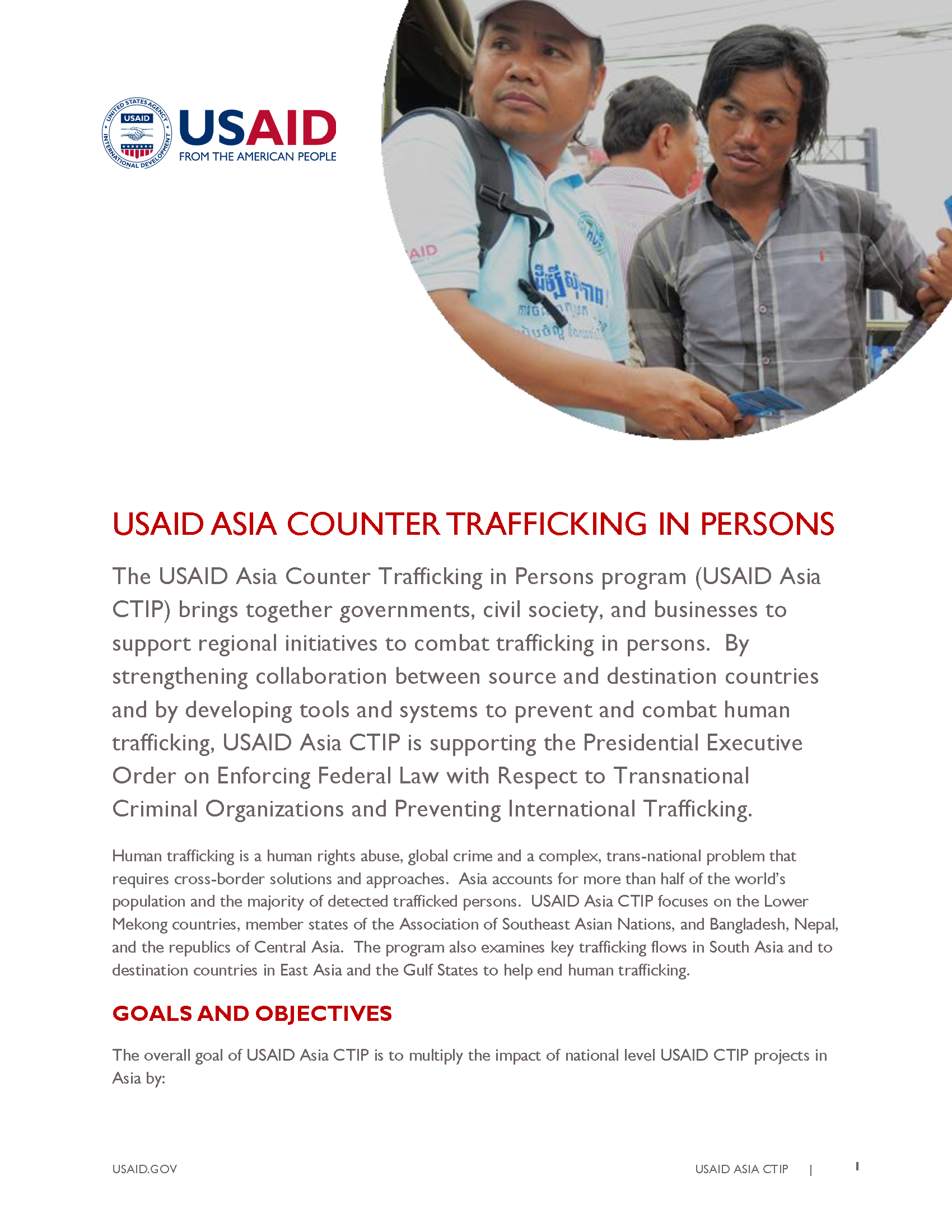Speeches Shim
USAID Asia Counter Trafficking in Persons ![]() (pdf - 124k)
(pdf - 124k)
The USAID Asia Counter Trafficking in Persons program (USAID Asia CTIP) brings together governments, civil society, and businesses to support regional initiatives to combat trafficking in persons. By strengthening collaboration between source and destination countries and by developing tools and systems to prevent and combat human trafficking, USAID Asia CTIP is supporting the Presidential Executive Order on Enforcing Federal Law with Respect to Transnational Criminal Organizations and Preventing International Trafficking.
Human trafficking is a human rights abuse, global crime and a complex, trans-national problem that requires cross-border solutions and approaches. Asia accounts for more than half of the world’s population and the majority of detected trafficked persons. USAID Asia CTIP focuses on the Lower Mekong countries, member states of the Association of Southeast Asian Nations, and Bangladesh, Nepal, and the republics of Central Asia. The program also examines key trafficking flows in South Asia and to destination countries in East Asia and the Gulf States to help end human trafficking.
GOALS AND OBJECTIVES
The overall goal of USAID Asia CTIP is to multiply the impact of national level USAID CTIP projects in Asia by:
Strengthening learning: USAID Asia CTIP is improving the quality of data and research related to CTIP activities and harmonizing the measurement of USAID CTIP programs across Asia. Specific activities in the region include research to standardize identification and support of trafficking victims to strengthen their access to services; the development of capacities and practical tools to measure programs’ successes and TIP prevalence; and the improvement of empirical evidence to inform successful interventions.
Increasing regional coordination and strengthening civil society action: USAID Asia CTIP is reinforcing regional civil society networks through online information sharing, skills building, and the development of tools to improve assistance to TIP survivors. The project is also building a series of Legal Impact Hubs to improve cross-border prosecution of TIP cases. At the national level, the project supports the implementation of bilateral and regional agreements (for example, the Memoranda of Understanding that govern legal labor migration between Cambodia and Thailand) through data-driven advocacy and the development of tools for monitoring the implementation of these agreements. USAID Asia CTIP is testing small-scale pilots (for example, designing a platform where recruiters and employers can connect to encourage transparency in a very sensitive sector) to ensure that new approaches are field-tested before taking to scale.
Increasing opportunities for private sector leadership: The program is linking with businesses in priority sectors—construction, agriculture, and domestic work—to develop and test tools to monitor and prevent TIP and the exploitation of vulnerable workers from recruitment to employment.
IMPACTS AND RESULTS
- Established a collaborative network that has allowed over 700 organizations working in CTIP to connect and exchange best practices and information in a secure way, including a Victim Journey Map, to help track trafficking routes.
- Assessed and documented a website used by low-skilled workers in Cambodia to find work locally, reducing the need to migrate to Thailand in potentially dangerous conditions. By sharing the lessons from this site across the region, the project is providing a replicable model for other countries seeking to address this challenge.
- Designed a research project in Malaysia on the migration corridor between Bangladesh and Malaysia to provide information on hidden recruitment costs and help both private companies and NGOs understand how to better support migrant workers.
- In partnership with a global company and the national-level USAID CTIP Thailand program, piloted sustainable technology for connectivity-at-sea that will link workers on fishing vessels to information and assistance resources to reduce their trafficking risk.
- Developed and disseminated 15 learning products to more than 400 local researchers and civil society organizations.


Comment
Make a general inquiry or suggest an improvement.